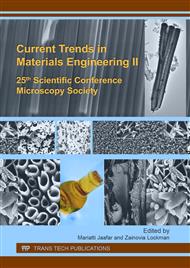p.87
p.91
p.95
p.99
p.103
p.107
p.112
p.116
p.120
Characteristics of FeCuAl Powder Compacts Formed through Uniaxial Die Compaction Route
Abstract:
This paper presents the development of FeCuAl powder compacts through uniaxial die compaction process. Iron powder ASC 100.29 was mechanically mixed with other elemental powders, i.e., copper (Cu), and aluminum (Al) for 30 minutes at a rotation of 30 rpm. The feedstock was subsequently shaped at three different temperatures, i.e., 30°C, 150°C, and 200°C through simultaneous upward and downward axial loading of 325 MPa. The as-pressed samples termed as green compacts were then sintered in argon gas fired furnace at 800°C for three different holding times, i.e., 30, 60, and 90 min at a rate of 10°C/min. The sintered samples were characterized for their relative density, electrical resistivity, and bending strength. The microstructure of the sintered samples was also evaluated through scanning electron microscopy (SEM). The results revealed that the sample formed at 150°C and sintered for 30 min obtained the best final characteristics, i.e., higher relative density, lower volumetric expansion and electrical resistivity, and higher bending strength. Microstructure evaluation also revealed that the sample formed at 150°C and sintered for 30 min obtained more homogeneous distribution of grains and less interconnected pores compared to the other samples.
Info:
Periodical:
Pages:
103-106
Citation:
Online since:
September 2017
Authors:
Price:
Сopyright:
© 2017 Trans Tech Publications Ltd. All Rights Reserved
Share:
Citation:


